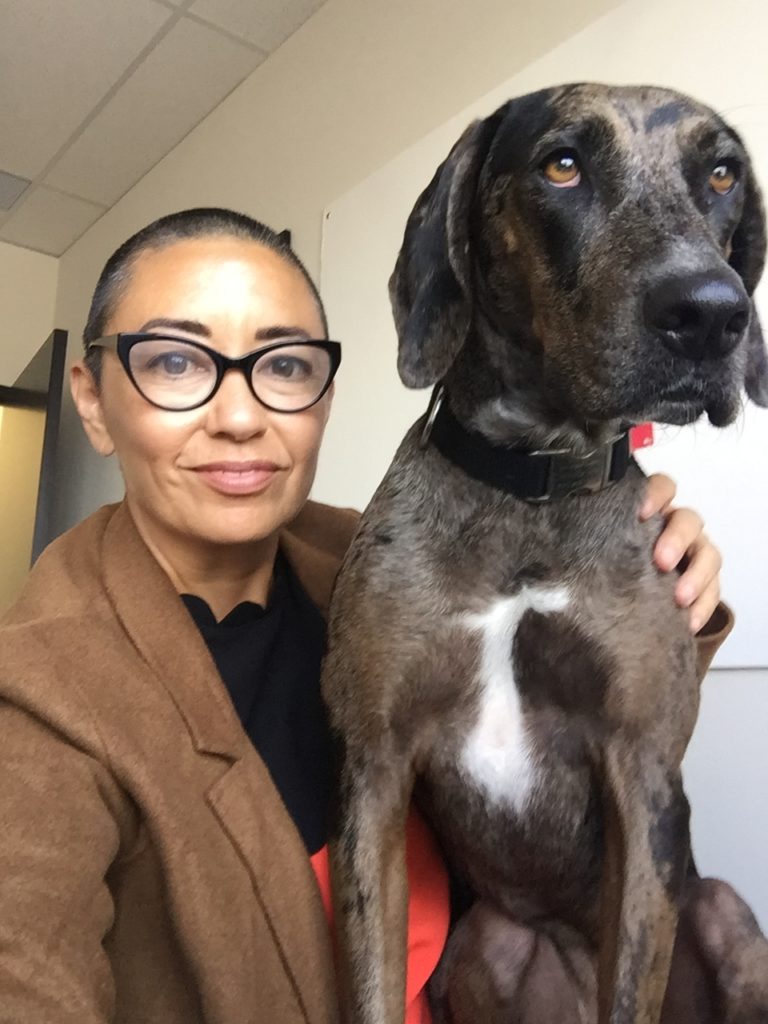 Ane and Georgia in the studio.
Ane and Georgia in the studio.
For our Below-the-Line special, Senior Producer Jackson Musker met up with costume designer Ane Carabtree (who brought along her dog, Georgia, to the studio).
Ane has designed costumes for shows like “The Sopranos,” “Masters of Sex,” “Westworld,” “Justified,” and “The Handmaid’s Tale,” for which she earned an Emmy nomination. The show, based on Margaret Atwood’s 1985 novel of the same name, is one of the breakout hits on Hulu this year.
Elisabeth Moss plays one of the “handmaids” — young women in a dystopian future who are forced to bear children to powerful men. Ane’s vibrant, unconventional costumes practically jump off-screen, and in recent months they have actually entered the real world: women around the country have taken to wearing these garments at protests.
Read below or listen to the audio above to find out what Ane thinks about her costumes becoming symbols of resistance, how the show’s signature costume element almost didn’t happen, and more.
On why the headdress/”wings” were a challenge for the costume and film crew
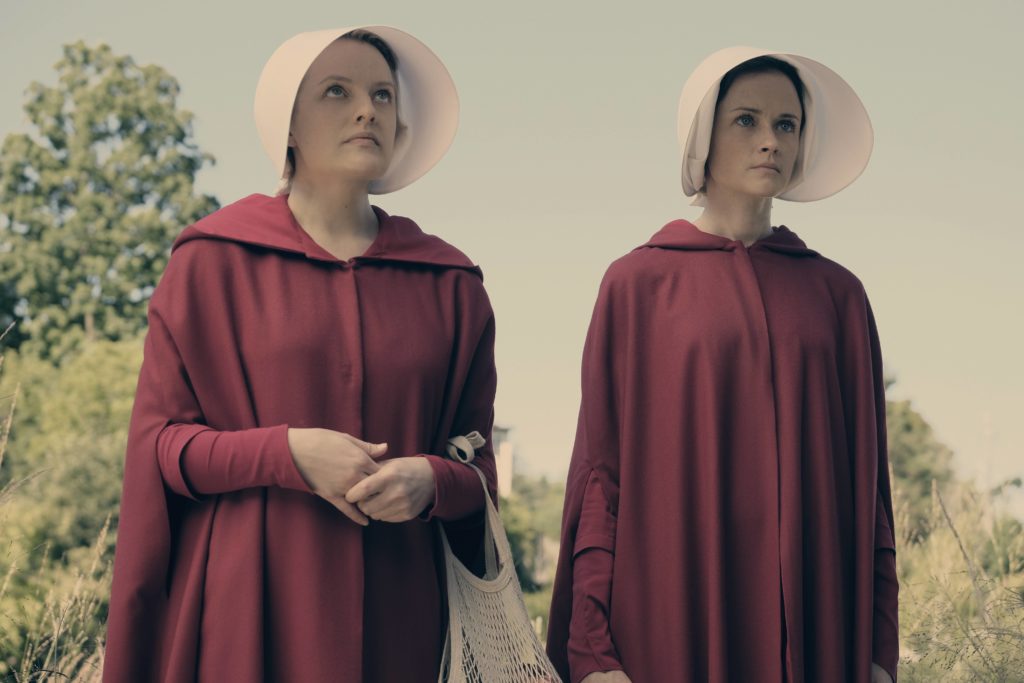 Offred (Elisabeth Moss) and Ofglen (Alexis Bledel) in a scene from “The Handmaid’s Tale.” (Photo Credit: George Kraychyk/Hulu)
Offred (Elisabeth Moss) and Ofglen (Alexis Bledel) in a scene from “The Handmaid’s Tale.” (Photo Credit: George Kraychyk/Hulu)
So, in the world and film and TV, you never… not you never… it is often normal to not cover an actor’s eyes or especially their heads because their emotions show on their face. And it’s a given that these cinematographer/art directors are going to freak if a pair of sunglasses or a hat shows up. Well, imagine a giant pair of wings– white on top of it.
We tried many different things instead of the wings. In the original film, they use scarves. And so I thought, “Oh, let’s try that. That could be another way.” And then, we decided to make [the wings] because it was true to the book.
We made a few different versions and I took them to New York to try them on Elisabeth Moss, and I just said, “Let’s film it. Let’s film it with my iPhone.” Which is dumb, but you know, you can make a short film. And we just had her look to camera and there was something super scary and so odd that it felt like the right thing for this world, this abstract world that was being created.
How the “wings” ended up enhancing the storytelling and actors’ performances
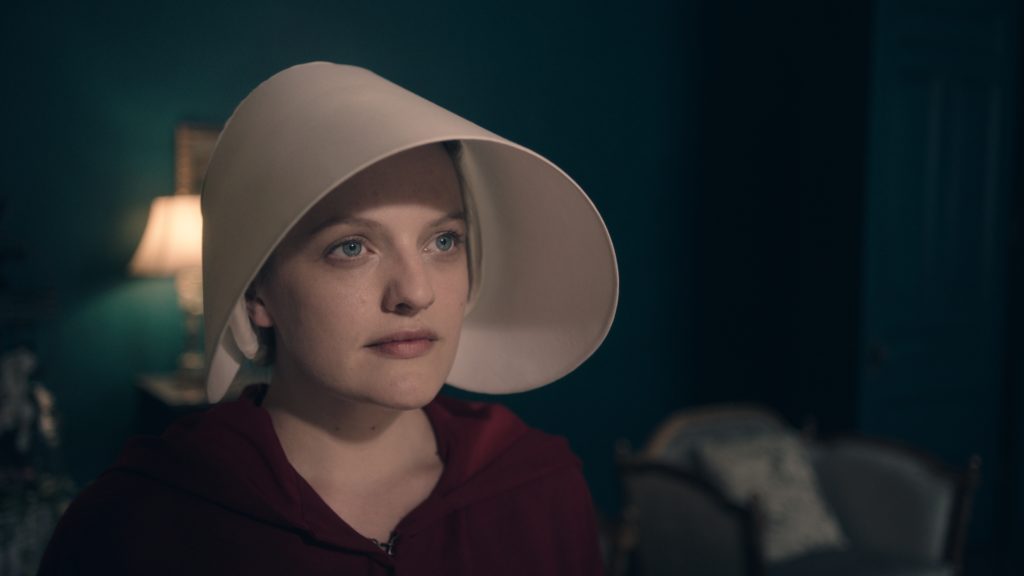 Offred (Elisabeth Moss), in a scene from “The Handmaid’s Tale.” (Photo Credit: Take Five/Hulu)
Offred (Elisabeth Moss), in a scene from “The Handmaid’s Tale.” (Photo Credit: Take Five/Hulu)
Ultimately, as the director, and the DP [director of photography], and the show’s creator looked at it — and at Lizzy Moss — they said, “You know what? We might start a whole new genre of cinematography, of cinema,” in a way, because the wings act as a sort of sound box that changes the way that you hear, what you can hear, and the way that you speak because it’s almost like blinders.
So for Lizzy and all of the handmaids, they all began to utilize that in the work as an actor to kind of create these private moments to highlight the fact that there was no privacy, that they were being controlled. But they could utilize the blinders to rule out people around, to hide behind and whisper information back and forth so that the guardians couldn’t see them.
The way that we constructed the wings — which, believe me, there were a million different try it — actually became a beautiful light box around these handmaids’ faces. But it would also cast shadows where you needed it to. We kind of made something great out of something horrific and scary that one should not use historically in film and TV. And I believe it worked in the end.
On the surprising inspiration for the handmaids’ flowing garments
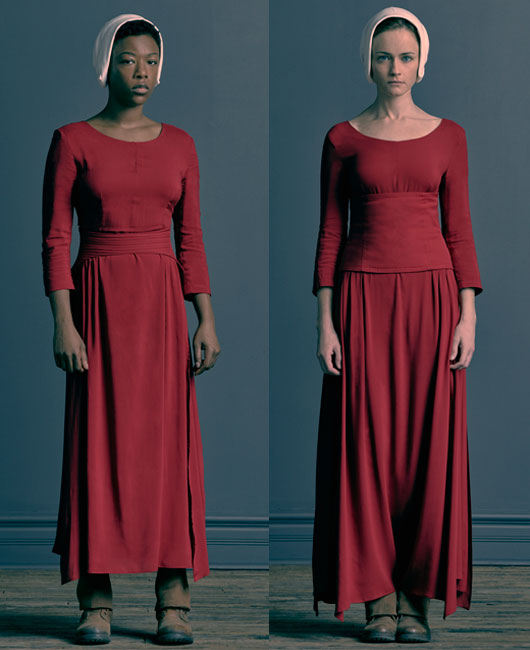 Samira Wiley and Alexis Bledel in their “Handmaid’s Tale” costumes. (Photo Credit: Jill Greenberg)
Samira Wiley and Alexis Bledel in their “Handmaid’s Tale” costumes. (Photo Credit: Jill Greenberg)
You know, I always wanted it to flow — this sounds gross, but also politic perhaps — like blood in water. To be sort of heavy, but light. And to move on its own because they’re in these dresses and this actual whole look — which is what I call a prison uniform — they’re in it for the whole of the show and the whole of their lives. And so you need something like movement to show that different things are happening and certainly I wanted it to be visually poetic and beautiful and emotional.
Believe it or not that movement, actually, it is as far back as the year 2000. I went to Italy, and there was then a priest walking through the Duomo in Milan — this is so specific, oddly — and there was a flap of long fabric in front of his robe and I remember sketching it really fast as he walked by and that flap of fabric on the handmaid’s dresses and also on the aunts’ [dresses] comes from that priest [laughs]. Because I noticed the movement and I wanted to achieve the same thing, I guess, someday later.
So that’s the kind of little moments that you squirrel away for, what, seventeen years later? It’s nuts, yeah. It doesn’t make any sense, but it works, you know?
On the handmaids’ costumes being used in political protests
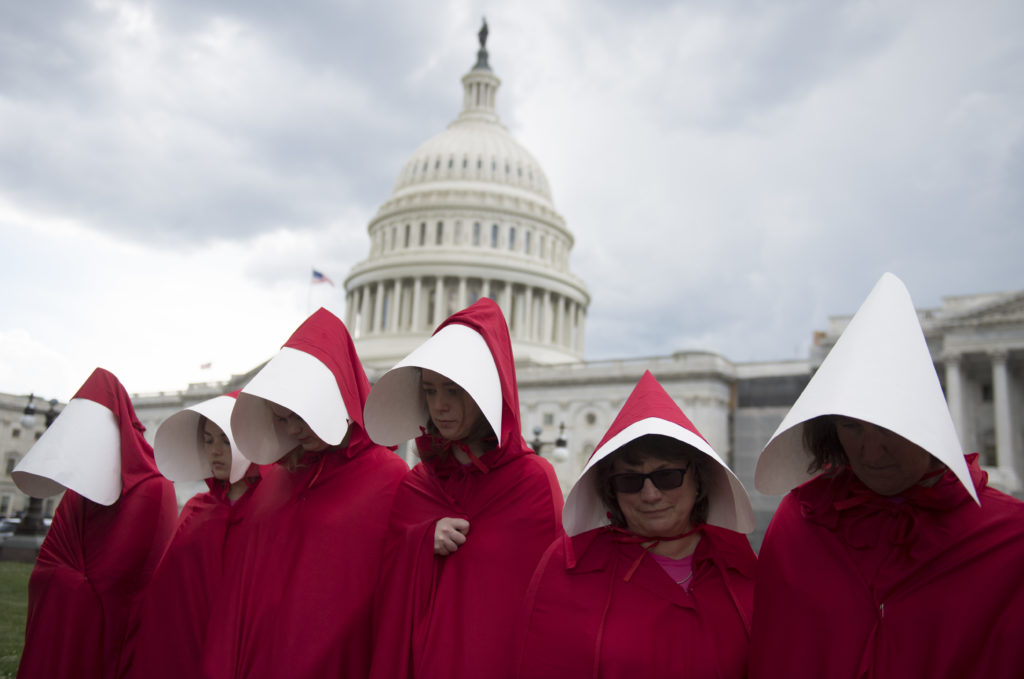 Supporters of Planned Parenthood dressed as characters from “The Handmaid’s Tale,” hold a rally as they protest the US Senate Republicans’ healthcare bill outside the US Capitol in Washington, DC, June 27, 2017. ( Photo Credit: SAUL LOEB/AFP/Getty Images)
Supporters of Planned Parenthood dressed as characters from “The Handmaid’s Tale,” hold a rally as they protest the US Senate Republicans’ healthcare bill outside the US Capitol in Washington, DC, June 27, 2017. ( Photo Credit: SAUL LOEB/AFP/Getty Images)
It has not affected my work — yet, I should say. What was happening in the world beyond people wearing the costumes as a protest measure, that affected my work. Because we started filming in September, the world changed in November [the election], and we kept creating the show until February.
And so of course what was happening in the world did inform my work. The very first protest was in Texas and they were protesting in the [State] Senate. And it was quite emotional for me because they reached out to me to ask for help and I felt almost embarrassed that they were going to this real-life thing and I had just, basically, done my job. And that kind of weird, strong emotion and pride mixed with [the thought that] “I am just merely a costume designer creating something” has been a strange dichotomy and a beautiful thing.
Listen, for women to take up something like that as a visual declaration — it’s so beautiful and so classy and hugely poignant for me as a woman and a woman who is representing certain groups that have been marginalized recently and in the past. It’s taking something from a fictitious story that is a hindrance, a prison uniform for women and it’s almost taking back women’s power. And all good comes from that.

